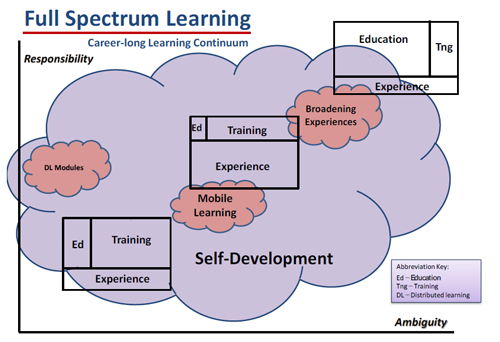- dumping the percentages
- combining Experience with Social Learning
- adding Education
- adding two continuums - Responsibility and Ambiguity

Percentages
70-20-10 has been problematic in at least two ways. As Dan Pontefract notes in his book, Flat Army, it is based on leaders who were in charge of hierarchical, command and control cultures that were prevalent in the 1980s. While the U.S. Army does have a hierarchical command and control culture due to its nature, it is also composed of flat or horizontal teams (large and small) that operate alone and with each other in complicated environments that often border on the edge of chaos. Thus, it is both a hierarchical and flat organization that not only approximates how most successful organizations operate today, but is also based on all people, rather than just senior leaders.Secondly, the use of percentages or ratios, such as 70-20-10 and 3-33, imply that they are predictive models, rather than reference models. In fact, the creators of 70-20-10 wrote that it is a predictive model. This can be noted in dozens of blog posts in which some very smart authors note 70-20-10 is a predictive model model and then are told in the comment sections that it is a reference model. If you do a image search on Google for the term "reference model" (may NSFW as it shows a couple of nude models) you will notice that none of the images are based on percentages or ratios.
Experience has Social Learning in a Learning Environment
The Full Spectrum Learning model realizes that if you are gaining experience to learn, then it is implied that you will be using plenty of informal and social learning, along with smaller amounts of training and education. In order to build skills and knowledge via experiences, the environment must contribute to peer-based learning through blogs, wikis, micro-blogs, and other social based media. It leverage these social tools to build dynamic vertical and horizontal social networks for formal and informal information sharing in order to foster critical thinking and problem solving skills needed for operational adaptability.The Addition of Education
In Human Resource Development, training is normally associated with learning to perform a present job or task, while education is normally associated with learning to perform a future job or task. Thus, in a rapidly changing world, education through formal and/or nonformal environments is a required component if an organization wants to remain competitive. For example, during our last recession, companies dumped thousands of people in mass layoffs. Now they are whining that they cannot find people who have the education and training that they require. Good organizations should always be building a path towards the future by educating people to walk that path.The Responsibility and Ambiguity Continuums
Rather than build a learning model that focuses on one fixed point, the U.S. Army created the Full Spectrum Learning model on two continuums based on the degree of responsibility of the learner and the degree of ambiguity of the learning environment to give it depth.What are your thoughts on the three models?
No comments:
Post a Comment